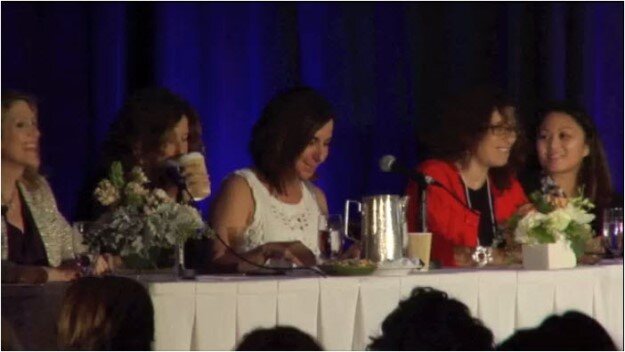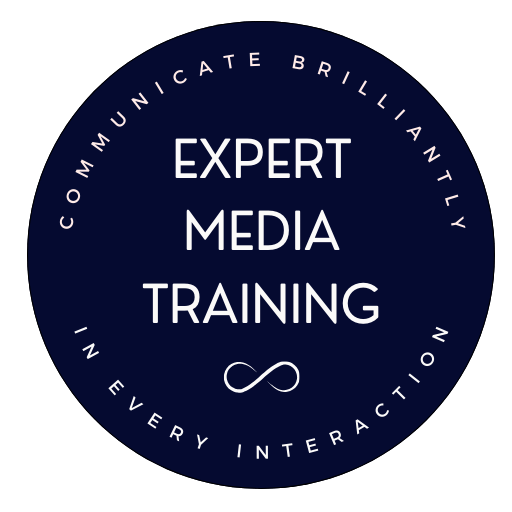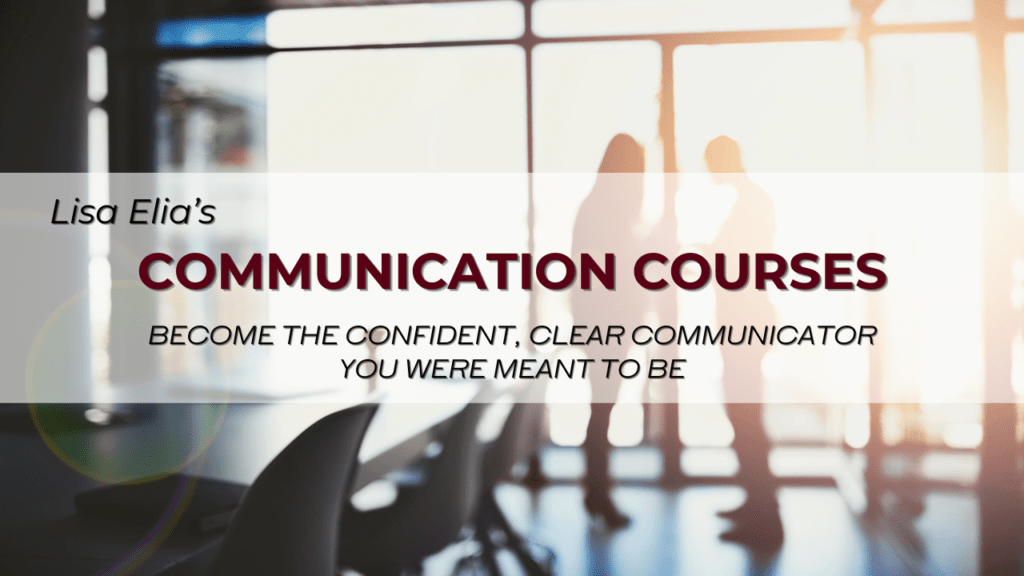
Wednesday, October 1, 2014 | Media Training
Why I Became a Media Trainer after Years as a Publicist
One of the reasons I began media training my clients when I was a publicist is that after sending clients through media training with other trainers, there were some things missing:
Most of the trainers I encountered were former journalists who were good at what they did overall, but most did not understand that many people who face media interviews did not choose the spotlight. Even many actors and music artists, who people might assume love the spotlight, do not necessarily love interviews with the media. Many people who appear to be confident in most situations can become nervous before or during interviews. NOT addressing potential nervousness and providing clients with specific techniques can leave a gap in their training.
I found myself taking clients through preparation techniques that I had learned years ago when I was refining my own skills as a public speaker, studying at Uta Hagen’s reputable HB Studios in New York, and with other internationally acclaimed speech and movement teachers in New York and Philadelphia.
The second reason that I became a media trainer is that I was able to incorporate more business strategy into client’s training sessions than I had witnessed from other trainers.
 Media interviews provide a unique opportunity to reach thousands or millions of people through a trusted medium. There are often layers of strategy and preparation that affect other aspects of a client’s career or company that should be considered when planning a media training session, in order to make the most of every media interview opportunity.
Media interviews provide a unique opportunity to reach thousands or millions of people through a trusted medium. There are often layers of strategy and preparation that affect other aspects of a client’s career or company that should be considered when planning a media training session, in order to make the most of every media interview opportunity.
Because I had spent years as a public relations professional, working with executives to create growth and distribution strategies and strategic alliances, I knew how important it was to train clients to think about their responses and behavior in media interviews within the context of their bigger goals.
As I began receiving media training requests from colleagues and friends of my clients, I knew the questions to ask in our preparation session to make the most of our media training sessions.
The quality of your media training can affect your brand and your bottom line.
As I began receiving requests to media train people who were not my public relations clients, I created methods and techniques to work with a wide variety of clients. I found that my formal education in communication (not broadcasting, but actual human communication) added great value to my training sessions.
Another reason I became a media trainer is that I saw that a few adjustments to a client’s communication behaviors could yield great benefits in many areas of their professional lives.
Sometimes small shifts in a client’s nonverbal behavior or communication style can make a significant difference in his or her effectiveness in every interview, speech, or conversation. One of the easiest and most natural situations in which to recommend such shifts is a media training or presentation training session.
By drawing upon my formal training in communication (not broadcasting, but verbal and nonverbal communication), I could provide feedback that went a bit deeper than what I had been seeing.
An additional reason I became a media trainer is that I have a broader perspective about what members of the media want than many media trainers who base their opinions only on the organizations where they worked as journalists.
The insights that I had gained from my decades of experience working with a wide array of top TV and radio bookers and journalists, to set up interviews and to shape show segments, have provided me with a breadth of knowledge about what will work best in a wide variety of media situations.
I have also interviewed numerous members of the media about what they like, do not like, and look for, in guests they interview. The outlets these media pros represent include The Associated Press, Clear Channel Radio, The Oprah Winfrey Show, The Los Angeles Times, SELF, Fitness, Natural Health, E! Entertainment, and many other top outlets.

One reason my media training practice continues to grow is that I have many very satisfied clients.
If you want to find out if my media training services are a good fit for you, set up a free consultation call.
Here are links to articles with media training tips:
For a Media Interview Checklist to keep on hand, click here.
To read my Top 5 Mistakes to Avoid in Media Interviews, click here.
To read How to Create an Online Press Room That the Media Will Love, click here.
For Media Training Tips on The Language of Your Brand in Media Interviews, click here.
Prepare for TV Interviews BEFORE You Book One. Click here.
If you would like to reach our office, call 310-479-0217.

Tuesday, September 9, 2014 | Media Training
When preparing for an interview, make sure you have all the items on your media interview checklist ready to go.

Many media interviews take place with very little notice. It’s not unusual to receive an interview request within hours (or minutes) of when it’s to take place.
You want to be prepared so that, even on your busiest days, you’re ready to say “yes” to a last-minute media interview request.
If you don’t one already, here’s a quick list of items to have ready before an interview:
1. your “elevator pitch” or introduction
2. key message points you want to deliver
3. a plan to handle the tough questions as well as the simple ones
4. specific calls to action that you want to incorporate into your responses
5. clothing and shoes ready to go (including jewelry and handbag/tote/briefcase, if any of these items suit you)
6. a plan for hair and make-up (men, you might need to have sheer powder on hand to reduce shine)
These are theitems to have ready before an interview, however, it is also important to receive proper media training if you haven’t already done so. If you require media training, you can find more information on our services here: https://expertmediatraining.com/services/.
For additional tips on media training and preparing for an interview, read some of our other blog posts:
Body Language in Interviews and Meetings – Nonverbal Communication:
Prepare for TV Interviews:
Tuesday, June 10, 2014 | Communication, Media Training, Presentation Training
The immediate feedback that you can receive with live media training is the best way to gain awareness of your body language, but the following tips will get you started.
Whether you’re meeting with a potential new client or a big decision maker who could change your life with a major deal, like an endorsement deal, a TV deal, or a book deal, paying attention to nonverbal communication (body language) can make or break the deal.
It is estimated that more than 90% of communication is nonverbal. People observe your nonverbal behaviors to determine whether you seem nervous, honest, confident, competent, and lots of other things.

What’s your body saying?
Here are body language do’s and don’ts for meetings:
Body Language Don’ts in Meetings:
Don’t slouch, as doing so can make you appear sloppy, uninterested or lacking in confidence.
Don’t stand with most of your weight leaning to one side, as this can make you appear less confident and less steady.
Don’t tilt your head too much, as it makes you appear unsure.
Don’t look down while you’re listening, as many people do: this could make you appear disengaged.
Don’t cross your legs and your ankles simultaneously (as some very flexible people do), as it makes you appear insecure.
Don’t cross your arms in front of you, as this can make you appear defensive.
Don’t play with your jewelry or anything else.
Don’t fidget. Watch your feet: fidgety feet are often the strongest indicator of nervousness, and a good interviewer may pick up on this.
Body Language Do’s in Meetings:
Offer your hand for a firm handshake, at the beginning and end of a meeting. If the person you are meeting has his or her hands full, or if he or she doesn’t respond, simply lower your hand.
Sit and stand with straight, but not stiff, posture. Your ears should be aligned above your shoulders.
Make eye contact with the person you’re speaking to, but don’t stare. It’s natural to look away periodically for a second or two.
Smile when you say hello and goodbye, and when you are talking about your greatest achievements.
Nod slightly in agreement when the person you are meeting with is telling you about himself or herself or the company or project, and smile when appropriate. Your body language will show your enthusiasm for the opportunity, and this is one of the things that people want to see.
Pay attention to the person’s nonverbal behavior. For example, if the person you are meeting with begins to look away or look at his or her watch while you are speaking, finish what you are saying quickly.
Before you go into your interview, roll your shoulders back and forth, take a few calming breaths and stretch your neck and body. All of these things will help to relax you, keep you out of “fight or flight” mode, and reduce the tension that can cause the shoulders to hunch and the diaphragm to be compressed. By opening and relaxing the body, you should have a stronger, steadier voice, and you should feel and appear more confident.
If you tend to fidget, simply cross your ankles.
If you want to learn more about body language and to sharpen all of your communication skills and you want a self-paced, online learning experience, explore my courses.
If you want to learn about our media training and presentation training services, click here: https://expertmediatraining.com/services
Contact us to arrange a consultation with Lisa.
Call us at 310-479-0217.
Friday, October 18, 2013 | Communication, Media Training, Public Speaking
The use of acronyms and abbreviations seems to have increased significantly over the past decade, primarily due to the growth of texting and the shrinking of sentences to fit within Twitter’s character limits.
The use of acronyms and abbreviations in media interviews or speeches can often create confusion, turn people off and, possibly, make you appear less eloquent than you are.
The difference between acronyms and abbreviations:
An acronym is pronounced like a word and is generally comprised of the first letter of each word in a phrase. Example: SWOT (which stands for “strengths, weaknesses, opportunities, threats”).
An abbreviation consists of the first letter of each word in a phrase or name, but each letter is pronounced individually. Example: D.I.Y. (which stands for “do it yourself”).
Of course, the above acronym and abbreviation could each have other meanings, but these are among the most common meanings for them. This brings me to the first of my tips for using acronyms and abbreviations effectively in media interviews or speeches:
1. Avoid using acronyms or abbreviations that could easily be confused with more commonly known ones. For example, if my team and I referred to our company as “E.M.T.”, rather than Expert Media Training™, a large percentage of people would be confused because “E.M.T.” is commonly used to describe an “emergency medical technician”. The difference is vast: if there’s a speech emergency I can help you, but you probably don’t want me intubating you.
2. Avoid using abbreviations or acronyms that may not be known to the majority of your audience. If you are in a media interview or giving a speech that will last more than a few minutes, and you plan on using an abbreviation to refer to something with a long name, explain this the first time you mention the full name associated with the abbreviation. This should be practiced during your media training, so you become fluid with your delivery.
3. If you can create an acronym for a system you have created or something else you want people to remember, this can be very useful for marketing and for making you memorable. If you plan to use the acronym in a media interview or speech, explain what it means early on.
4. In broadcast interviews or speeches, don’t use abbreviations that contain more syllables than the words themselves. Example: using “G.W.P.” (5 syllables) instead of “gift with purchase” (4 syllables). You could probably get away with this in an article you author, but this kind of “marketing speak” rarely impresses people.
5. If, during an interview or speech, you use abbreviations that are replacements for slang expressions, like “LOL” or “OMG”, know that this will convey a certain image of you. If you use these facetiously, it will shape your image in a different way.
6. If you use too many acronyms or abbreviations throughout your interview or speech, people may think you spend too much time texting and not enough time working…unless you work in social media, perhaps.
7. Choose your acronyms and abbreviations as consciously as you would other words and phrases, and you should be fine. I was tempted to use a lot of acronyms here, but I didn’t want you to TIWAJ. (I’ll let your imagination work on what TIWAJ could mean.)
For more media training and presentation training tips provided by Media Trainer Lisa Elia, the founder of Expert Media Training™, visit https://expertmediatraining.com/blog
Wednesday, April 10, 2013 | Interview Skills, Media Training

I was on Entertainment Tonight recently, sharing my PR and media training expertise.
This was my fourth segment with ET, and the show producers had called me two other times when I wasn’t able to tape the segments due to scheduling conflicts. However, I believe that one of the reasons the producers have called me so much is that I’m easy to work with.
As a media trainer, I offer you these tips to prepare for TV interviews:
1. If you are positioning yourself as an expert, stay up on research, trends and news related to your field and think about how to articulate various aspects of your work so that you can easily answer questions about it. If you have not had media training yet, do not wait until the day before you have an interview. Get it as soon as you begin to think about putting yourself into the public eye so that you have time to work with your media trainer on creating clear responses to questions and on polishing your delivery.
2. Have your preparation ritual down, so that you can center yourself and get your energy up with very little notice. Quite often, you will receive requests for interviews that must take place within hours, or sometimes minutes. Having a good preparation ritual that you use to get in performance mode can give you the confidence to say “yes” to great opportunities, even when you are very busy.
Preparation rituals are included in all of our programs. When we have provided media training for actors or music artists, we have observed that they love our techniques, because they are based in acting training and movement training.
When we provide media training for athletes, they too appreciate the use of a quick preparation ritual, as most of them use them in their professional work.
3. Knowing that many media interviews come up very quickly (sometimes with less than 24 hours’ notice), have your wardrobe ready to go, have your hair cut and colored the way you want it, nails manicured, etc., at all times. This is the life of a public figure, which is what you become if you put yourself out into the public eye as an expert.
4. Try to accommodate last-minute media requests, if you can. If you say “no”, someone else will say “yes”.
Suze Orman skyrocketed into the public spotlight because she told the producers of The Oprah Winfrey Show that she could be an emergency guest. They asked her to fly in and sit in the front row so they could ask her a question: she answered it so much to Oprah’s liking that Oprah asked her back, and rest is history.
You can watch my interviews on Entertainment Tonight and learn more about the media interviews that have arisen for me as a media trainer and PR expert at https://expertmediatraining.com/press-room/.
To further prepare for TV interviews, use the quick list of items to have ready to go, which you can find on this blog post:
Here are some other links you may find useful in preparing for media interviews:
Media Training Resources
https://expertmediatraining.com/media-training-resources/
Top 10 Media Relations Tips – Media Training Tips
https://expertmediatraining.com/media-training-tips-for-good-media-relations/
Frequently Asked Questions about Media Training
https://expertmediatraining.com/faqs-about-media-training/
Monday, January 14, 2013 | Media Training
Have you put off seeking press coverage because you don’t feel ready or you don’t know how to present yourself to the media?
This is a valid concern, and the following information will help you to prepare yourself.
Here are three things you need to “be” before you begin, which will help you learn how to present yourself to the media:
1. Be willing to shape your messaging to suit the needs of the media. There is a manner in which media outlets capture their audience’s attention. You must speak their language.
2. Be open to setting up a simple system that will make it easier to receive an abundance of new business inquiries and product orders.
3. Be responsive. You must respond to feedback and requests from the media promptly.
Now that you have tips on how to present yourself to the media, go deeper.
Here are some helpful links:
Media Training and Presentation Training Videos — They’re filled with tips.
Top Media Interview and Communication Tips
Glossary of Media Interview Terms
Prepare for TV Interviews Before You Book One
Friday, November 2, 2012 | Interview Skills, Media Training, Public Speaking
“Committing to the moment” is something almost any acting student hears over and over again. However, anyone who speaks publicly or who is interviewed by the media can also benefit from creating a practice to help them commit to the moment.
Ideally, in any interview or presentation situation, you want to be completely engaged. The moment you stop listening or being fully present, even for a nanosecond, you risk missing an important point or not answering a question as eloquently as you’d like.
When you truly commit to the moment, with the understanding that every time you are being interviewed by the media or speaking to a group that is your only opportunity to reach your audience with your message at that precise time in history, you will be effective and you will have few regrets.
The ability to commit to the moment generally comes from your habits and preparation. Consider the following:
How do you clear your head and focus on the interview or presentation, without allowing your mind to wander on to other matters awaiting you at the office or elsewhere?
Do you have a ritual to help you shift your attention from whatever you were doing prior to an interview and onto the interview itself?
Do you maintain daily habits that keep your mind sharp and your energy up?
I recommend practicing being fully committed to the moment during situations where the stakes are not very high, such as a casual staff meeting or even when you’re walking down the street or buying a latte. If you’re generally a multi-tasker, it may take some concentrated effort to really listen and connect with the barista or to notice the sights, sounds and smells around you. Doing this on a regular basis will help you become more aware of the sensation of being fully present.
Now that you have tips on how to commit to the moment, do you need additional media training information? Check out these blog posts:
What Are We Saving It For? A Media Trainer’s Thoughts on Committing to the Moment
Top 5 Mistakes to Avoid in Media Interviews
Top 10 Media Relations Tips – Media Training Tips from a Media Trainer
Media Training Tips on The Language of Your Brand in Media Interviews
For additional communication tips, check out my Confident and Clear Communication program.
Thursday, November 1, 2012 | Crisis Communication, Media Relations, Media Training
If your company has been affected by Hurricane Sandy, create a communications plan to address the concerns of each target audience–employees, clients and customers, investors, shareholders. Address how the company is taking measures to restore strength and make up for lost income and productivity or property damage.
People want to experience a company’s awareness and receive assurance in times like these.
For more detailed information on creating a crisis communications plan, read our previous blog post on this topic.
To arrange a free consultation, call us at 310-479-0217.
Or, you can email us at team@expertmediatraining.com
Tuesday, October 2, 2012 | Media Relations, Media Training, Messaging, On-camera
 With the increase in opportunities for people to be interviewed by a variety of outlets, more people are becoming aware of the need for media training. As more people begin to make their own videos they may also see that it’s not always as easy as it looks to deliver content in a smooth, engaging way. Add to this the pressure of being asked questions by an inquisitive reporter and you could have a nerve-racking situation. BUT, that doesn’t have to be the case.
With the increase in opportunities for people to be interviewed by a variety of outlets, more people are becoming aware of the need for media training. As more people begin to make their own videos they may also see that it’s not always as easy as it looks to deliver content in a smooth, engaging way. Add to this the pressure of being asked questions by an inquisitive reporter and you could have a nerve-racking situation. BUT, that doesn’t have to be the case.
Like anything else you want to master, learning to handle interviews well just takes practice and guidance. Being a great speaker from the stage or being comfortable making your own promotional videos is not the same as being ready for a media interview.
Here’s my analogy. Rocking out on the dance floor is to the dancing the tango beautifully, what creating your own videos well is to being great in a media interview. To explain: you may be someone who’s comfortable and even looks good freestyling on the dance floor (like creating your own videos). But, would you be able to do the tango without lessons and practice? The tango is precise and intricate and it takes practice to make it smooth and crisp (like being able to answer questions concisely, without hesitancy and with great energy).
Just as you would get training if you wanted to do the tango well, you should get media training if you want to interview well.
You may have seen my other media interview video tips, and this one will give you more to think about.
Watch the media interview video below for some quick media training tips.
Here are more resources you can access on our site.
Frequently Asked Questions about Media Training
https://expertmediatraining.com/faqs-about-media-training/
Media Interview Checklist from a Los Angeles Media Trainer
https://expertmediatraining.com/media-interview-checklist-from-a-media-trainer/
How to Create an Online Press Room That the Media Will Love
https://expertmediatraining.com/online-press-room-tips-from-media-trainer/
Prepare for TV Interviews BEFORE You Book One – Tips from an LA Media Trainer and Spokesperson
https://expertmediatraining.com/prepare-for-tv-interviews-media-trainer-tips/
Wednesday, September 12, 2012 | Media Relations, Media Training, Messaging, On-camera
Many years ago, when I was working as a publicist, I had a client who INSISTED that she didn’t need media training because she had been interviewed by the press and had created some of her own promotional videos. When I booked her on an NBC segment, she was unaware that a second camera was on her while the interviewer spoke. What was caught on camera? It was my client looking down at the ground, appearing disengaged. NOT GOOD! Easily avoidable media interview mistakes like this are the reason I now insist on media training my clients, or at least doing a mock interview or two with them, to make sure they’re truly camera-ready and media-ready.
If you plan or hope to be interviewed by media outlets, from the smallest online radio shows to the largest national TV shows, I encourage you to invest in media training from an experienced pro, so that you become aware of media interview mistakes that can be avoided. In the meantime, this article will help you avoid some of the most common mistakes people make in media interviews.
These are five media interview mistakes to avoid:
Media Interview Mistake # 1: Assuming you’re “a natural” because you’re a good public speaker or you’re good at making your own promotional videos. When you control the situation, it’s much easier to shine. When you have the pressure of answering questions quickly with cameras on you or a live audience listening in, it can be much more challenging and can fluster even the most confident people.
Tip: Practice being interviewed by a challenging interviewer. (When I conduct media training sessions, one of the many things I do is to play “jerky reporter” and ask tough, sometimes obnoxiously rude questions and then I help you develop answers and strategies to deal with this type of situation in the real world.)
Media Interview Mistake # 2: Providing long, meandering answers to questions. Many TV and radio interviews are very brief, lasting just a few minutes. So, you have to provide concise, meaningful responses to questions. Brevity is important in print interviews, too. A magazine editor I know said that one interview subject she spoke with went on and on about himself for so long during a telephone interview that she stopped taking notes and started cleaning her house…while he was still blabbing on about himself. Don’t be THAT person.
Tip: Get your messaging down. Think of answers to the most common questions you think you will get and rehearse them, but not word-for-word; just get the content down. (Messaging is one of the first things I work with clients to develop. It informs everything, from the way we develop your press kit materials, to the verbiage used on your web site, to the way you introduce yourself to people.)
Media Interview Mistake # 3: Not knowing enough about the media outlet and its audience. The more you understand the media outlet you’re being interviewed for, the better able you will be to communicate with the interviewer or host appropriately and provide examples or anecdotes that suit the outlet’s audience.
Tip: Research the media outlet and the interviewer prior to your interview. If you’re going to be on a TV show, watch it. If you’re going to be on a radio show that you’re not able to access, spend time on the station’s web site to get a feel for it. Read any print publication where you will be interviewed and, in particular, read articles authored by the person who will be interviewing you.
Media Interview Mistake #4: Trying to be funny when you’re not. Not everyone has the gift of good comedic delivery. While humor is welcomed in many interviews, don’t try to force it because it won’t come off well.
Tip: Be the best version of yourself. Don’t try to be someone you’re not. Sometimes a straightforward, clear interview is EXACTLY what the outlet wants and EXACTLY what will attract potential clients or speaker bookers or sponsors who may be watching or listening to you.
Media Interview Mistake #5: Being unaware of the camera. You can’t just BE on camera and forget about, although the most polished show hosts and guests make it look that way.
Tip: Ask how much of your body is included in the shot and where the camera operator wants you to look. Sometimes you will be asked to look at the camera, sometimes next to it and sometimes somewhere else. It varies from show to show.
There’s much more to share about techniques to control your nerves and manage your energy, how to deliver your message in pyramid form, how to incorporate a call to action and lots of other techniques. However, true media training is experiential. There’s nothing like being in the process and learning in a hands-on (or on-camera) way.
By dodging these media interview mistakes, your interviews will run smoothly, and you’ll be more likely to be interviewed again!
Share these media interview mistakes to avoid on social media, by using the share buttons below.
Now that you know some of the most common media interview mistakes to avoid, do you need additional media training resources?
Here are some resources that you can access on our site.
Prepare for TV Interviews BEFORE You Book One
https://expertmediatraining.com/prepare-for-tv-interviews-media-trainer-tips/
Media Interview Checklist
https://expertmediatraining.com/media-interview-checklist-from-a-media-trainer/
Media Training Resources
https://expertmediatraining.com/media-training-resources/
Top 10 Media Relations Tips – Media Training Tips
https://expertmediatraining.com/media-training-tips-for-good-media-relations/
Frequently Asked Questions about Media Training
https://expertmediatraining.com/faqs-about-media-training/
If all the world’s a stage, own it while you’re on it!

 Media interviews provide a unique opportunity to reach thousands or millions of people through a trusted medium. There are often layers of strategy and preparation that affect other aspects of a client’s career or company that should be considered when planning a media training session, in order to make the most of every media interview opportunity.
Media interviews provide a unique opportunity to reach thousands or millions of people through a trusted medium. There are often layers of strategy and preparation that affect other aspects of a client’s career or company that should be considered when planning a media training session, in order to make the most of every media interview opportunity.







